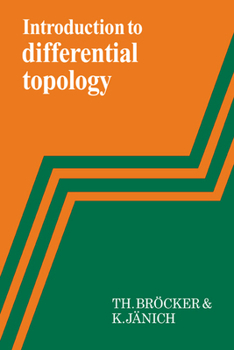Introduction to Differential Topology
Select Format
Select Condition 
Book Overview
This book is intended as an elementary introduction to differential manifolds. The authors concentrate on the intuitive geometric aspects and explain not only the basic properties but also teach how to do the basic geometrical constructions. An integral part of the work are the many diagrams which illustrate the proofs. The text is liberally supplied with exercises and will be welcomed by students with some basic knowledge of analysis and topology.
Format:Paperback
Language:English
ISBN:0521284708
ISBN13:9780521284707
Release Date:October 1982
Publisher:Cambridge University Press
Length:172 Pages
Weight:0.58 lbs.
Dimensions:0.4" x 6.0" x 9.0"
Customer Reviews
1 rating
Excellent graduate-level introduction, slightly marred by poor editing & translation
Published by Thriftbooks.com User , 16 years ago
Broecker & Jaenich's "Introduction to Differential Topology" is the best book for (reasonably proficient) first-year graduate students to acquire the basic tools for studying the topological aspects of smooth manifolds. Originally written in German in 1973 (as Einführung in die Differentialtopologie) and then translated into English in 1982, it has a high reputation among mathematicians, being praised by, e.g., Milnor and Brieskorn. In fact, Barden & Thomas were motivated to write their own book, An Introduction to Differential Manifolds, in part by the fact that this book was out of print; but now Cambridge has reprinted it. Although an introduction, it would probably be considered too difficult by most undergraduates, as it moves rather quickly and assumes knowledge of basic topology and analysis. In contrast to, say, Guillemin & Pollack's Differential Topology, terms are always defined precisely (e.g., manifolds are 2nd countable and not assumed to be subsets of R^n) and there is relatively little motivating discussion, but rather it immediately launches into the subject. While it thoroughly covers the basics of differential topology - immersions and submanifolds, tangent and vector bundles, partitions of unity, transversality, isotopies, tubular neighborhoods, flows, Whitney's and Sard's theorems - there is no treatment of more advanced topics, such as Morse theory, surgery, or handlebodies (as in Hirsch's Differential Topology or Kosinski's Differential Manifolds), and there is only a brief mention of (co)bordism. Moreover, Riemann metrics are barely used and other diffeo-geometric/analytic aspects of smooth manifolds - differential forms, integration, Lie groups, de Rham cohomology, the Frobenius theorem - are not even hinted at, so this is definitely not fungible with Lee's Introduction to Smooth Manifolds or even Barden & Thomas. Where the book really distinguishes itself is its conciseness, efficiency, and rigorousness. Despite keeping verbosity to a minimum (in contrast to, say, Lee), some very clear and complete explanations of key concepts are presented, such as the comparison of 3 different definitions of tangent spaces (the "algebraist's, physicist's, and geometer's" definitions), which helps to sort out any confusion the reader may have acquired from other sources. Usually, more general versions of theorems are given, yet with short proofs, such as that of Whitney's embedding theorem, Sard's theorem, the existence of collars, and the transversality theorems, and theorems are expressed in precise modern language, such as by the use of germs in the rank and inverse function theorems. Following Lang's Differential and Riemannian Manifolds (but more accessibly), dynamical systems and sprays are introduced and used to construct isotopies of embeddings and tubular neighborhoods. There's a refreshing lack of handwaving, with, e.g., connected sums and manifolds with corners being handled properly in the differential case; in fac





